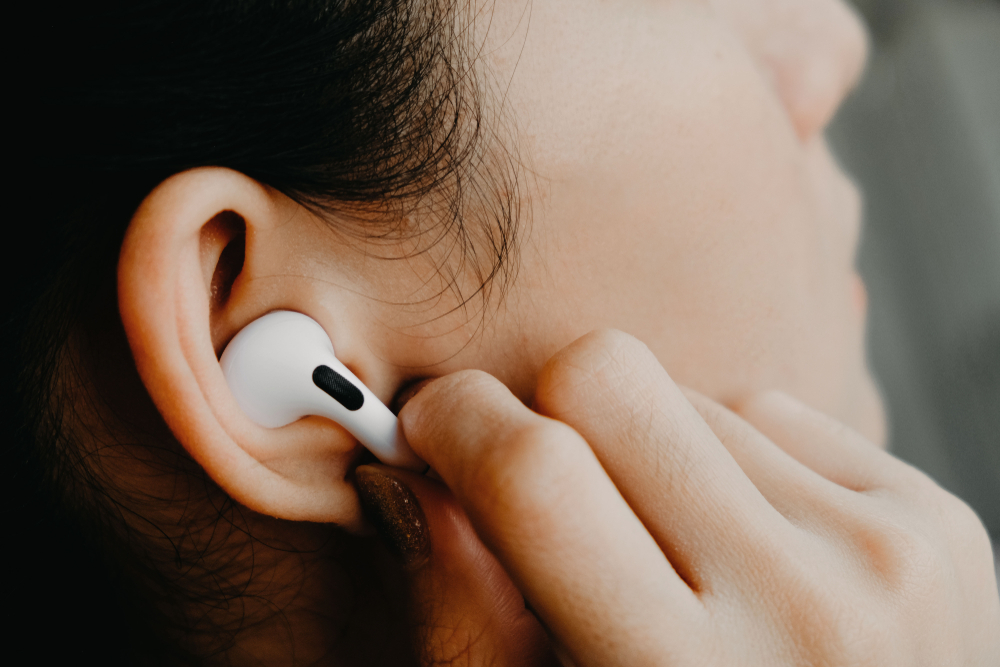In our relentless quest for convenience, we’ve welcomed a myriad of wireless technologies into our lives, from smartphones that fit into our pockets to earphones that offer us music without the tangle of wires. Among these innovations, wireless earphones, particularly Apple’s AirPods, have emerged as the emblem of this wireless era. They offer not just freedom from cables but a statement of living on the tech-forward edge. However, beneath this seamless experience of consuming music and making calls lies a question we seldom pause to consider: at what cost does this convenience come, especially to our health?
The phasing out of the traditional earphone jack, a once indispensable feature of smartphones, marks a significant shift towards a wireless future. This move, led by tech giants like Apple and quickly followed by others, suggests a future where our choices for listening to music or communicating are inevitably tied to wireless options. But as we embrace these devices with open arms, concerns about their health implications quietly bubble in the background. Are these sleek gadgets as harmless as they seem, or are we overlooking potential health risks in favor of convenience?
Join us as we unravel the narrative surrounding wireless earphones and their health implications. From the debate on electromagnetic field (EMF) radiation to expert opinions and global petitions, we’ll explore whether the invisible cost of wireless freedom might be more significant than we anticipated. This journey is not just about questioning the gadgets we’ve grown to love but about fostering a more informed and health-conscious approach to technology in our lives.1
The Wireless Revolution and Its Impact on Our Lives
The transition to wireless earphones, symbolized by Apple’s pioneering AirPods, represents a significant milestone in the evolution of personal technology. This shift from traditional wired headphones to wireless options marks not just a leap in convenience but also a substantial change in how we interact with our devices and, by extension, the world around us. The allure of a cord-free experience—whether it’s in listening to music, handling calls, or engaging with smart devices—epitomizes the broader trend towards seamless, unobtrusive technology that aims to enhance our daily routines without the physical limitations of wires.
However, this wireless revolution brings with it questions about the long-term implications for our health. As devices like AirPods become ubiquitous, nestled within the ears of millions worldwide, concerns arise about the exposure to electromagnetic fields (EMF) radiation. These concerns stem from the fact that wireless earphones, along with other wireless devices, emit low levels of EMF radiation as part of their operation. The debate over the safety of this radiation is not new, but the widespread adoption of wireless technology has reignited it, prompting a fresh examination of what this means for our well-being.
Amidst the convenience and the sleek design of wireless earphones lies a complex balance between embracing technological advancements and addressing potential health risks. The transition to a wire-free lifestyle is not merely about aesthetics or convenience; it’s about understanding the broader implications of these technologies on our health and environment. As we continue to navigate this wireless age, it’s crucial that we stay informed about the potential effects of EMF radiation, fostering a dialogue that balances progress with well-being. This journey into wireless technology is not just about what we gain in terms of convenience but also what we must consider and address to ensure that our health remains a priority in the face of innovation.
Understanding EMF Radiation and Health Concerns
As the wireless revolution accelerates, bringing with it devices like AirPods that promise freedom from tangled wires, a critical health conversation emerges. At the heart of this discussion is electromagnetic field (EMF) radiation, a type of energy emitted by wireless devices. While the convenience of wireless earphones is clear, so is the need for a deeper understanding of EMF radiation and its potential impact on human health. The concern among medical professionals and researchers revolves around the long-term exposure to EMF, particularly the close proximity of devices like wireless earphones to our brains, which could potentially increase our risk of adverse health effects.
Research into EMF radiation has intensified, reflecting growing concerns about the ubiquity of wireless technology in our lives. Studies have explored how EMF, despite being non-ionizing and not directly damaging to DNA in the same way as ionizing radiation, might still affect biological systems in subtle yet significant ways. The debate is not about dismissing the benefits of wireless technology outright but about fostering a balanced understanding of its use. The goal is to encourage a dialogue that places equal emphasis on technological advancement and health safety, ensuring that consumers are informed and precautions are taken to minimize potential risks.
Navigating the wireless age requires more than just an appreciation for the convenience it offers; it demands a commitment to understanding and addressing the health implications of our increasingly connected world. By prioritizing research and adopting a cautious approach to the use of wireless devices, we can enjoy the benefits of technology while also safeguarding our health. This dialogue is essential as we continue to integrate wireless devices into our daily lives, seeking ways to minimize our exposure to EMF radiation without sacrificing the conveniences that have become integral to our modern lifestyle.
The Broader Implications of Wireless Adoption
As we delve deeper into the age of wireless technology, it’s crucial to consider not just the direct health implications of EMF radiation but also the broader societal and environmental impacts of this shift. The move towards wireless earphones like AirPods and other Bluetooth-enabled devices underscores a significant change in our consumption patterns and technological dependencies. This transition, while offering unprecedented convenience and connectivity, also raises questions about electronic waste, resource consumption, and the sustainability of our tech-driven lifestyles.
Moreover, the widespread adoption of wireless devices influences social behaviors and interactions. The convenience of wireless earphones, for example, has transformed how we engage with media, communicate with others, and experience the world around us. While these devices enable a more personal and immersive interaction with technology, they also pose challenges to social connectivity and present barriers to face-to-face interactions. Balancing the benefits of wireless technology with its potential to isolate individuals from their physical environments and communities is another dimension of this complex landscape.
In addressing the broader implications of wireless adoption, it’s essential to foster a holistic view that encompasses health, environmental sustainability, and social well-being. By advocating for responsible innovation and consumption practices, we can embrace the advantages of wireless technology while mitigating its negative impacts. This approach requires collaboration among manufacturers, consumers, policymakers, and researchers to ensure that our march towards a wireless future is both progressive and sustainable.
Navigating Health Risks and Safety Measures
Understanding how to navigate the potential health risks associated with wireless technologies, such as earphones, is essential in our increasingly connected world. The concerns about EMF radiation, significant as they are, can be addressed through awareness, education, and practical safety measures. By informing ourselves about the nature of EMF radiation and its potential impacts, we empower ourselves to make informed decisions regarding our usage of wireless devices.2
Adopting practical measures to reduce exposure can mitigate potential risks effectively. For instance, opting for wired earphones or using the speakerphone function during calls can significantly limit direct exposure to EMF radiation. Keeping wireless devices away from the body when not in use and limiting usage duration are also key strategies for reducing exposure. Additionally, making use of device settings such as airplane mode, which cuts off wireless communications, can further decrease EMF radiation exposure when connectivity is not essential.
In navigating the health risks associated with wireless earphones and other devices, adopting a balanced and informed approach is vital. By staying informed about the potential risks, taking practical steps to reduce exposure, and supporting technological advancements aimed at minimizing EMF emissions, we can enjoy the conveniences of wireless technology while safeguarding our health. This proactive stance allows us to embrace technological advancements mindfully, ensuring our well-being in the wireless age.

Embracing a Balanced Approach to Technology Use
In the era of rapid technological advancement, finding a balanced approach to using wireless devices, including earphones, becomes crucial for maintaining our health and well-being. This balance involves not only understanding and mitigating potential health risks but also recognizing and managing the impact of technology on our lives. The goal is to harness the benefits of wireless innovations while ensuring they contribute positively to our lifestyle, without compromising our physical or mental health.3
A key aspect of achieving this balance is setting personal boundaries for technology use. This means being mindful of the time spent using wireless devices and ensuring that this usage does not detract from physical activity, face-to-face interactions, and other aspects of a healthy lifestyle. It’s about making conscious choices to disconnect when necessary, promoting a healthier relationship with technology. For instance, dedicating specific times of the day to be device-free can help foster better sleep habits, reduce stress, and improve personal relationships.
Additionally, incorporating technology that monitors and promotes health can further enhance our well-being. Devices and apps that track physical activity, sleep patterns, and meditation practices can be valuable tools in our quest for a balanced lifestyle. These technologies, when used judiciously, can support our health goals by providing insights and feedback that encourage positive habits and behaviors.
Embracing a balanced approach to technology use requires a conscious effort to integrate wireless devices into our lives in a way that supports our health and well-being. By setting boundaries, staying informed about potential risks, and leveraging technology to enhance our health, we can enjoy the benefits of the wireless age without letting it detract from our quality of life. This approach allows us to maintain a healthy equilibrium in our relationship with technology, ensuring that it serves us in the best possible way.

My Personal RX on Navigating the Wireless Age with Health in Mind
As a doctor deeply invested in the intersection of technology and health, I’ve observed firsthand the challenges and opportunities presented by our increasingly wireless world. While the convenience of wireless devices, including earphones, has transformed our daily lives, it’s essential to approach their use with a health-conscious mindset. Here are my personal recommendations for maintaining your well-being in the age of wireless technology:
- Limit Your Daily Use: Start with monitoring how much time you spend using wireless devices. Setting limits can help reduce potential EMF exposure and also encourage more physical activity.
- Opt for Wired Alternatives: Whenever possible, choose wired earphones or headphones over wireless options to minimize direct EMF exposure to your brain and body.
- Maintain Distance: Keep your wireless devices, such as smartphones and tablets, away from your body when not in use. Utilize speakerphone modes or text messages instead of placing calls directly to your ear.
- Embrace Airplane Mode: Make it a habit to switch your devices to airplane mode when you’re not using them, especially at night. This simple step significantly reduces EMF radiation exposure.
- Prioritize Sleep Hygiene: Ensure your sleeping area is free from electronic devices. The reduction in EMF exposure can contribute to a deeper, more restorative sleep.
- Use my Vitamin K2 + D3 & Magnesium Bundle: Incorporating this supplement bundle into your daily routine can support your overall health, including bone health and cognitive function, which is especially important in our tech-saturated environment.
- Stay Hydrated: Drinking plenty of water can help your body naturally detoxify from the various stressors it encounters, including EMF radiation.
- Adopt a Holistic Health Guide: The Protocol e-book is an invaluable resource that offers comprehensive strategies for enhancing your well-being, from diet and exercise to minimizing exposure to environmental toxins.
- Engage in Regular Physical Activity: Exercise not only counteracts the sedentary lifestyle associated with heavy device use but also supports your body’s natural detoxification processes.
- Mindful Meditation: Regular meditation can help mitigate the stress that prolonged technology use may impose on your mental health, promoting a more balanced approach to digital consumption.
Adopting these practices can help you enjoy the benefits of our wireless age without compromising your health. Remember, it’s about finding the right balance that works for you, ensuring that technology serves as a tool for enhancing your life, not detracting from it.

Sources:
- Radiation: Electromagnetic fields. (n.d.). https://www.who.int/news-room/questions-and-answers/item/radiation-electromagnetic-fields ↩︎
- Editor. (2021, October 31). The 10 detrimental health effects of wireless devices – EMFSA. EMFSA. https://www.emfsa.co.za/news/10-detrimental-health-effects-wireless-devices/ ↩︎
- The impact of rapid technological change on sustainable development. (2020, February 17). UNCTAD. https://unctad.org/publication/impact-rapid-technological-change-sustainable-development ↩︎












 Subscribe to Ask Dr. Nandi YouTube Channel
Subscribe to Ask Dr. Nandi YouTube Channel










